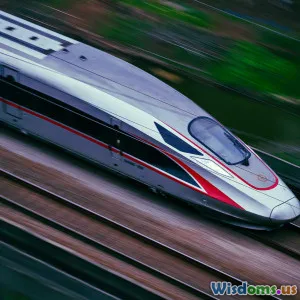
How Smart Sensors Transform Train Fleet Inspections
15 min read Discover how smart sensors revolutionize train fleet inspections, enhancing safety, efficiency, and predictive maintenance through real-time data and advanced analytics. (0 Reviews)
How Smart Sensors Transform Train Fleet Inspections
Introduction: Riding the Rails into the Future
Picture a high-speed train hurtling down the tracks at 300 kilometers per hour, each component working in unison to deliver passengers safely and swiftly to their destinations. But what quietly ensures this ballet of technology remains safe, reliable, and on schedule? Historically, it’s been an army of dedicated inspectors, armed with flashlights and checklists. Today, however, a silent revolution is underway – and at its heart are smart sensors, reshaping how train fleets are inspected and maintained. From AI-powered fault prediction to real-time remote monitoring, smart sensors are not only improving efficiency; they’re raising the bar for rail safety and redefining what’s possible for the rail industry and its passengers.
The Old World: Manual Inspections and Their Limits
Before the smart sensor era, train fleet inspections relied heavily on human expertise. Teams would routinely disassemble components, visually inspect brakes, axles, bearings, and more, hunting for subtle signs of wear. While diligent, this approach revealed several limitations:
- Time-consuming: Manual inspections meant trains spent more time in depots than on the rails.
- Human error: Fatigue, oversight, and limited access could cause missed defects.
- Delayed maintenance: Problems found only during scheduled checks, sometimes after causing breakdowns or accidents.
- Rising costs: Frequent strip-downs wore out parts prematurely and stretched labor budgets.
In a 2022 study, the International Union of Railways (UIC) cited that up to 30% of manual inspections failed to identify early-stage defects—leaving room for improvement and innovation.
The Sensor Revolution: A Data-Driven Era
Smart sensors are digital devices designed to monitor, record, and wirelessly transmit critical data on train systems. These compact, robust sensors are increasingly being installed throughout train fleets, from the wheelsets to HVAC units, transforming inspection and maintenance in several profound ways:
What Are Smart Sensors in Rail?
Smart sensors go far beyond simple data logging. Equipped with microprocessors and connectivity, they analyze information in real-time, detect anomalies, and communicate directly with central management or cloud-based platforms. Key parameters monitored include:
- Vibration (accelerometers): Key to detecting issues in wheels, axles, and bogies.
- Temperature sensors: Essential for bearings, brakes, and electrical components.
- Acoustic sensors: Useful for identifying abnormal noise signatures, signaling wear or impending failure.
- Strain gauges: Monitoring metal stress, crucial in preventing catastrophic mechanical failures.
A single high-speed train may house thousands of individual sensors, each forming a node in the Internet of Things (IoT) ecosystem.
Example: German Railways (Deutsche Bahn)
German national operator Deutsche Bahn invested €60 million in digital maintenance, equipping over 30,000 freight wagons with smart sensors. The result? A reported 50% reduction in unscheduled maintenance events within two years.
Key Benefits of Smart Sensor-Driven Inspections
1. Real-Time Condition Monitoring
Real-time data is game-changing. Sensors aboard a train constantly feed data on performance, alerting operators the moment a metric strays from the norm. For example, if a bearing runs too hot or a vibration signature changes abruptly, the system flags it at once—much earlier than traditional human detection.
Case Study: SNCF (France’s National Railway Company) SNCF implemented vibration and temperature sensors along its TGV high-speed fleet. Thanks to continuous feedback, SNCF reduced derailment risk and boosted average fleet availability by 7% in less than five years. According to their Director of Digital Operations, “We went from reacting at scheduled stops to intervening at the earliest indication of trouble—resulting in fewer breakdowns and improved passenger confidence.”
2. Predictive (Not Just Preventive) Maintenance
Before sensors, technicians relied on periodic, preventive maintenance—replacing parts on schedule, whether they showed signs of wear or not. This was inefficient: parts were retired too soon or, less commonly, too late. Smart sensors introduce predictive maintenance, harnessing machine learning algorithms and big data.
- Historical Data Analysis: Repeated sensor readings build a digital profile of each component’s lifecycle.
- AI Predicts Failures: Advanced analytics compare current readings against thousands of historical cases to forecast breakdowns before they happen.
A 2020 McKinsey report showed predictive maintenance in railways can lower maintenance costs by up to 30% while reducing service delays by 40%.
3. Minimizing Downtime, Maximizing Fleet Availability
With sensors continuously surveilling trains, maintenance teams no longer operate on blind schedules, but instead intervene only where—and when—needed.
Example: London Underground The London Underground upgraded its Circle line with sensor systems that detect door mechanism anomalies. Instead of idly checking every train, maintenance is now targeted, cutting downtime by months yearly and allowing more carriages to remain in active service, reducing pressure during rush hours.
4. Safety: Risk Reduction through Early Warnings
Sensor-enabled inspection means potentially dangerous faults are detected long before they lead to accidents.
- Bearing failures: Often catastrophic, identifying overheating just-in-time can forestall potential derailments.
- Wheel/track interface: Abnormal wear patterns can be flagged, preventing wheel cracks or flat spots, which can pose derailment risks or cause passenger discomfort.
Japan’s Shinkansen bullet trains employ a sensor and AI network capable of detecting microscopic rail flaws too subtle for the human eye, allowing maintenance teams to intervene proactively—one critical reason for its celebrated safety record.
5. Cost Savings and Environmental Gains
Maintenance optimized by sensor data reduces unnecessary part replacement and labor, driving down operational costs. Furthermore, fewer breakdowns mean reduced energy waste (from emergency stops) and less resource consumption overall.
A 2021 European Railway Agency (ERA) evaluation projected that EU-wide rollout of smart sensor-based maintenance could save the continent’s rail sector over €5 billion annually, slashing CO2 emissions by up to 450,000 tons a year.
Key Technologies Powering Smart Sensors
Miniaturized, Ruggedized Devices
Rail environments can be hostile—trains vibrate, experience extreme temperatures, and are exposed to dust and moisture. Modern rail sensors are engineered for durability and accuracy, featuring protective coatings, self-calibrating circuits, and long-life batteries optimized for years of continuous operation.
Wireless Connectivity and IoT Platforms
Wireless transmission (via 4G, 5G, or proprietary railway networks) enables massive amounts of data to be streamed from moving trains to data hubs or the cloud. IoT platforms integrate this flood of information for advanced analysis and actionable, real-time insights.
Artificial Intelligence (AI) and Machine Learning
Software leverages AI algorithms to learn “normal” patterns for each asset and flag anomalies instantly. Whether it’s an AI engine predicting axle fatigue or identifying an abnormal acoustic signature, these technologies sharpen over time, gaining diagnostic precision.
Cybersecurity Concerns
With increased connectivity comes risk. Rail networks are actively investing in end-to-end encryption, secured sensor hardware, and network segmentation to protect against cyber threats which, while rare, could have serious safety or reliability implications.
Real-World Implementations: From Prototypes to Global Standards
Alstom HealthHub (Europe/North America)
Alstom developed HealthHub, a digital railway maintenance solution relying heavily on on-board and trackside sensors. HealthHub uses sets of non-contact sensors, such as wayside laser inspection and infrared devices, to simultaneously monitor multiple parameters like wheel profiles, disc brake wear, and undercarriage integrity as trains pass at speed.
A single HealthHub installation in the UK detected an axle crack within hours, averting a potential breakdown, and has been widely credited for increasing network operational efficiency by up to 25%.
Indian Railways: Moving towards Digital Inspections
India, with one of the largest rail networks globally, is mid-way through its “Mission Rail Digitization.” Early pilot deployment of onboard vibration and temperature sensors across key freight routes resulted in a 15% reduction in unscheduled goods train failures in the very first year.
The Minister of Railways stated, “Our goal is transformational safety and efficiency—smart sensors are vital to making Indian railways future-ready.”
Metros and Urban Rail: Smarter Mobility for Cities
Singapore’s Mass Rapid Transit (MRT) and Hong Kong’s MTR both leverage sensor-driven systems to battle Asia’s punishing urban rail demands. Onboard sensors monitor everything from air conditioning performance (critical for commuter comfort) to real-time brake pad thickness, ensuring smooth, uninterrupted service.
The Road (or Track) Ahead: Challenges and Opportunities
Integration with Legacy Fleets
Retrofitting older trains with sensor arrays presents challenges: space constraints, power supply mismatch, and integration with non-digital components. Nevertheless, specialized battery-powered, wireless sensors and edge computing nodes are allowing gradual upgrades without major fleet replacements.
Data Deluge: Making Sense of the Signals
Each train can produce up to several terabytes of sensor data annually. Rail operators need expansive storage solutions and sophisticated analytics to distinguish actual issues from harmless sensor “noise.” Partnerships with big data companies and adoption of cloud platforms (such as Microsoft Azure or Amazon Web Services’ railway-specific tools) are increasingly standard.
Regulatory Compliance and Standards
Ensuring interoperability, safety, and data privacy compliance is critical. The European Union Agency for Railways (ERA) and the Federal Railroad Administration (FRA) in the US are shaping harmonized standards for rail IoT, helping streamline sensor deployment globally.
Workforce Transformation: From Inspectors to Data Analysts
Far from eliminating jobs, smart sensors are shifting rail workers’ focus from repetitive manual inspections to higher-value roles in data analysis, remote diagnostics, and predictive maintenance planning – upskilling and future-proofing the entire sector.
Quote:
“Tomorrow’s railway inspector is a data detective, using smart sensors to anticipate problems—not just react,” says Lisa Moritz, Senior Systems Engineer at Siemens Mobility.
The Ripple Effect: Wider Industry and Societal Impacts
Customer Experience
Improved fleet reliability means fewer service disruptions, more accurate departure times, enhanced onboard comfort, and ultimately, higher public trust in rail travel.
Environmental Improvements
Cutting out inefficiencies translates from the depot to the planet: less over-maintenance, better timing, fewer breakdowns, and lower emissions uphold rail’s claim as the greenest mode of mass transit.
Economic and Competitive Advantage
Countries and companies adopting smart sensor-driven maintenance gain a lead in cost-competitiveness and safety reputation, attracting future investments in their rail sectors. A 2023 UN Transport Report highlighted rail digitalization—centered on smart sensors—as a cornerstone for resilient, sustainable, and modern public transport systems worldwide.
Conclusion: The Smart Sensor Express
The world’s rail networks, often centuries-old, are leaping into a new digital age powered by smart sensors. What began with a quest to improve safety and reduce costs has blossomed into a historic transformation, fundamentally altering how train fleets are inspected, maintained, and operated.
With real-time insights, predictive maintenance, and better asset management, railways are crossing today’s limits in safety, reliability, and efficiency. Though challenges of integration, data processing, and upskilling remain, the benefits are both immediate and profound—from safer rail journeys and shrunken carbon footprints to empowered workforces and seamless passenger experiences.
As sensor technology evolves further—to embrace AI, edge computing, and even more sensitive detectors—train fleet inspections will only become smarter, faster, and more indispensable. So, the next time you board a train, remember: behind the click of the closing doors and the rhythmic hum of the tracks, an invisible network of sensors is working tirelessly, shaping the journey today, and laying the tracks for a more innovative rail future.
Rate the Post
User Reviews
Other posts in Vehicle Maintenance & Fleet Management
Popular Posts














